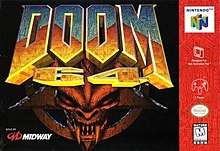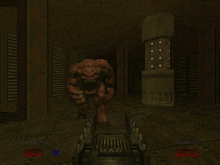Doom 64
Doom 64 is a 1997 first-person shooter game developed and published by Midway Games for the Nintendo 64. It is a sequel to Doom II (1994). A remastered port was released for Windows, Nintendo Switch, PlayStation 4, and Xbox One in March 2020, and on Stadia in May 2020.
| Doom 64 | |
|---|---|
 North American Nintendo 64 cover art | |
| Developer(s) | Midway Games Nightdive Studios (re-release) |
| Publisher(s) |
|
| Designer(s) |
|
| Programmer(s) | Aaron Seeler |
| Artist(s) | Sukru Gilman |
| Composer(s) | Aubrey Hodges |
| Series | Doom |
| Engine | id Tech 1 Kex Engine (re-release) |
| Platform(s) | Nintendo 64, Microsoft Windows, Nintendo Switch, PlayStation 4, Xbox One, Stadia |
| Release | Nintendo 64
Win, NS, PS4, XBO
|
| Genre(s) | First-person shooter |
| Mode(s) | Single-player |
Gameplay

Doom 64 plays similarly to earlier games in the Doom series; the player must advance through 32 levels battling demons, collecting weapons and keys, and activating switches to reach the level's exit while surviving deadly ambushes and traps. Changes were made to the Doom engine for use in Doom 64, and gameplay elements were altered.
Weapons
All the weapons from Doom II are present,[1] but redrawn with new sprites and sound effects.[2] The chainsaw has two blades instead of one, the fists have bloodstained gloves instead of brass knuckles, the plasma gun has an electric core that emits a sparking sound when equipped, the rocket launcher has a small kick when fired, pushing the player back slightly, the shotgun's priming handle is at the grip instead of under the barrel, and the double-barreled "Super" shotgun reloads faster and causes recoil.
A new weapon known as the Laser, or "Unmaker", was added, using the same cell ammunition as the plasma gun and BFG 9000. It was first mentioned in the Doom Bible and was planned to be featured in the PC Doom games, but never appeared. Its appearance in Doom 64 is its only official appearance prior to Doom Eternal, albeit spelled "Unmaykr" in that game. With the power of three ancient artifacts found in the game, it becomes more powerful by shooting three laser beams (at a quicker rate than default) instead of one. The first artifact increases the laser speed, the second artifact adds a second laser, and the third artifact allows the weapon to fire three simultaneous lasers which can automatically aim separately from one another, allowing the weapon to attack three different enemies at once.
Plot
Following the Doom Marine's success thwarting hell in Doom and Doom II: Hell on Earth, a planetary policy is established to quarantine the UAC research installations with apocalyptic levels of radiation. For years, the installations stood motionless and abandoned, until a long forgotten satellite monitoring one of the installations, barely functioning due to years of being subjected to the high levels of radiation, sends a message back to Earth.
The message indicates that a single entity, with vast rejuvenation powers and masked by the extreme radiation levels, managed to escape detection. This entity systematically altered decaying dead carnage back into corrupted living tissue, resurrecting the demons.
As the only experienced survivor of the "DOOM" episodes, the Doom Marine is sent in alone to exterminate them. Later, he realizes the demons had planned for this, after he unknowingly allowed himself to be lured back into hell. Despite this, the demons are unable to defeat him, and with the Unmaker, he eventually battles and kills the Mother Demon. The game ends with the Doom Marine, no longer capable of having a normal life following his encounters with hell's forces, deciding to remain in hell forever to ensure no demon ever rises again.
Development
Doom 64 was developed by Midway Games at its San Diego studio. id Software, the primary developer of the Doom franchise, supervised the project.[3] Development began in late 1994.[4] Midway's original title of the game was The Absolution, however the name was changed to Doom 64 for brand recognition ("The Absolution" was reused as the name of the last level in the game). Midway wanted to include every demon from the original games, as well as a few extra levels, into the final product, but deadlines and memory constraints of the small capacity of the N64 cartridges made them scrap the levels and leave a few demons out of the game. Midway stated that a multiplayer mode was not included because Nintendo did not provide the necessary resources for multiplayer programming. The developer justified the decision based on alleged slowdown during split-screen multiplayer in other games on the console and the competitive nature of the mode. "Everyone knows that the best part of playing multiplayer is not knowing where your opponent is," stated a Midway representative, "and with a four-player split-screen, everyone can easily see where their opponents are."[5]
The environments were built from 3-dimensional polygon models, while the enemies were created by pre-rendering sprites with SGI workstations.[6] The Nightmare Imp was originally developed for the PlayStation version of Doom and appeared in a near-complete beta of the game,[7] but was removed just prior to release for unknown reasons. As such, it made its debut in Doom 64 instead.[1]
Doom 64 was slated to be a North American launch title, but near the deadline id Software expressed dissatisfaction with many of the level designs, so Midway postponed the game until April 1997 while they worked on redesigning the levels.[8] Nintendo's then-recent decision to remove the ability to run over animals from the Nintendo 64 version of Cruis'n USA raised concerns about the possibility of Doom 64 being censored, but Midway vice president of software Mike Abbot said Nintendo had not voiced any concerns about the game's violent content. He pointed out that Cruis'n USA was perceived by the public as a family game, while the Doom series was targeted towards mature gamers, making violent content less of a concern.[6]
The music and sound effects were composed by Aubrey Hodges, who also created the original sound effects and music for the PlayStation port of Doom two years earlier. The original Doom 64 team was working on a potential sequel titled Doom Absolution designed only for two-player deathmatches not long after the first game was released, but decided to scrap it. Because id Software were impressed with their work on Doom 64, they were assigned to the Nintendo 64 version of Quake at this time,[9] and this presumably kept them too busy to work on other projects.
Midway Home Entertainment shipped Doom 64 on March 29, 1997, for release on April 4.[10]
Reception
| Reception | ||||||||||||||||||
|---|---|---|---|---|---|---|---|---|---|---|---|---|---|---|---|---|---|---|
| ||||||||||||||||||
By the time Doom 64 was released, the original Doom had received ports on nearly every platform capable of running it. Critics agreed that Doom 64 was by far the best-looking Doom to date, exceeding even the PC version,[11][12][13][14][18] and were enthusiastic about the level designs, deeming them imaginative and much more challenging than those of the original Doom.[11][13][14][18] A Next Generation critic remarked that "even the most skillful Doom fans will have their hands full. And pushing door switches often causes whole rooms to rearrange and fold out into new shapes."[14]
However, most reviewers felt that the new graphics and levels were not enough to keep the game from feeling like yet another port of the original Doom.[12][13][14] Peer Schneider of IGN concluded, "Make no mistake about it, this is the best update to Doom so far -- but if you've played the PC, PSX, SNES, Mac, Saturn, etc versions to death, you can do without this one."[13] GamePro disagreed with the majority on this point, stating that "Doom 64 pumps the tried-and-true corridor-shooter formula full of life, with another challenging, intense experience that showcases the system's capabilities." They rated it a perfect 5.0 out of 5 in all four categories (graphics, sound, control, and fun factor).[18] Shawn Smith of Electronic Gaming Monthly instead regarded the lack of advancements in the basic Doom gameplay as a positive: "Some of you may want to see your space Marine jumping around or swimming underwater. Purists wouldn't want these features added because Doom wasn't about that stuff. I'll have to agree with the purists."[11]
Most critics praised the game's musical score for its atmospheric effect.[11][12][13][18] Schneider and GamePro were both pleased with how well the analog control works,[13][18] but Jeff Gerstmann of GameSpot felt it was off and said of the game overall, "On paper, Doom 64 sounds better than the original could ever hope to be, but the end result feels more like a bastardization of the original."[12] Comparing it to contemporary Nintendo 64 shooter Turok: Dinosaur Hunter, Schneider and GamePro both remarked that Doom 64 has less freedom of exploration and depth of control, but is more intense and "anxiety-filled".[13][18]
In the following years, Doom 64 has garnered a cult following from fans, with Patrick Klepek from Kotaku describing it as the most underrated Doom game.[19]
Re-release
Ports of Doom 64 for PC, Nintendo Switch, PlayStation 4 and Xbox One by Nightdive Studios were released on 20th March 2020 and for Stadia on 12th May 2020.[20] The ports were included as a bonus for those who pre-ordered Doom Eternal, and include a new chapter, with the player battling the Mother Demon's sister.[20]
References
- "Doom 64: Doom Never Looked so Doomed Good". Electronic Gaming Monthly. No. 92. Ziff Davis. March 1997. p. 95.
- "Doom 64: Nothing Can Save You!". GamePro. No. 102. IDG. March 1997. p. 44.
- IGN staff (November 11, 1996). "Doom 64 News". IGN. Archived from the original on November 5, 2014. Retrieved July 8, 2013.
- "Williams Makes Jaguar, Ultra 64 Plans". GamePro. No. 76. IDG. January 1995. p. 210.
- IGN staff (December 29, 1996). "Doom 64 Gets the Multiplayer Axe". IGN. Archived from the original on December 29, 2014. Retrieved July 8, 2013.
- "NG Alphas: Doom 64". Next Generation. No. 26. Imagine Media. February 1997. pp. 81–82.
- "Doom: The Ultimate Version of the Greatest Gore Blast Ever!". Maximum: The Video Game Magazine. No. 2. Emap International Limited. November 1995. pp. 56–60.
- "In the Studio". Next Generation. No. 20. Imagine Media. August 1996. p. 17.
- "In the Studio". Next Generation. No. 28. Imagine Media. April 1997. p. 19.
Impressed by Nintendo 64's conversion of Doom, id Software immediately granted the Quake conversion rights to Midway, even requesting that the same Doom team be responsible.
- IGN Staff (March 28, 1997). "Midway Ships Doom Tomorrow". IGN.
- "Review Crew: Doom 64". Electronic Gaming Monthly. No. 94. Ziff Davis. May 1997. p. 54.
- Gerstmann, Jeff (April 8, 1997). "Doom 64 Review". GameSpot. Retrieved July 25, 2018.
- Schneider, Peer (January 28, 1997). "Doom 64". IGN. Archived from the original on July 26, 2018. Retrieved July 25, 2018.
- "Finals: Doom 64". Next Generation. No. 29. Imagine Media. May 1997. p. 142.
- Reseigh-Lincoln, Dom (March 20, 2020). "Doom 64 Review (Switch eShop)". Nintendo Life. Retrieved April 9, 2020.
- Rairdin, John (March 24, 2020). "Doom 64 (Switch) Review". Nintendo World Report. Retrieved April 9, 2020.
- TD3.com (March 19, 2016). "Doom 64 - im Klassik-Import-Test (N64) – MANIAC.de". MANIAC.de (in German). Retrieved November 22, 2018.
- Major Mike (April 1997). "Nintendo 64 ProReview: Doom 64". GamePro. No. 103. IDG. pp. 74–75.
- Klepek, Patrick (June 9, 2016). "Doom 64 Is The Most Underrated Doom Game". Kotaku. Retrieved October 13, 2019.
- Wales, Matt (March 10, 2020). "Doom 64's upcoming port will add a brand-new post-campaign chapter". Eurogamer. Retrieved March 29, 2020.